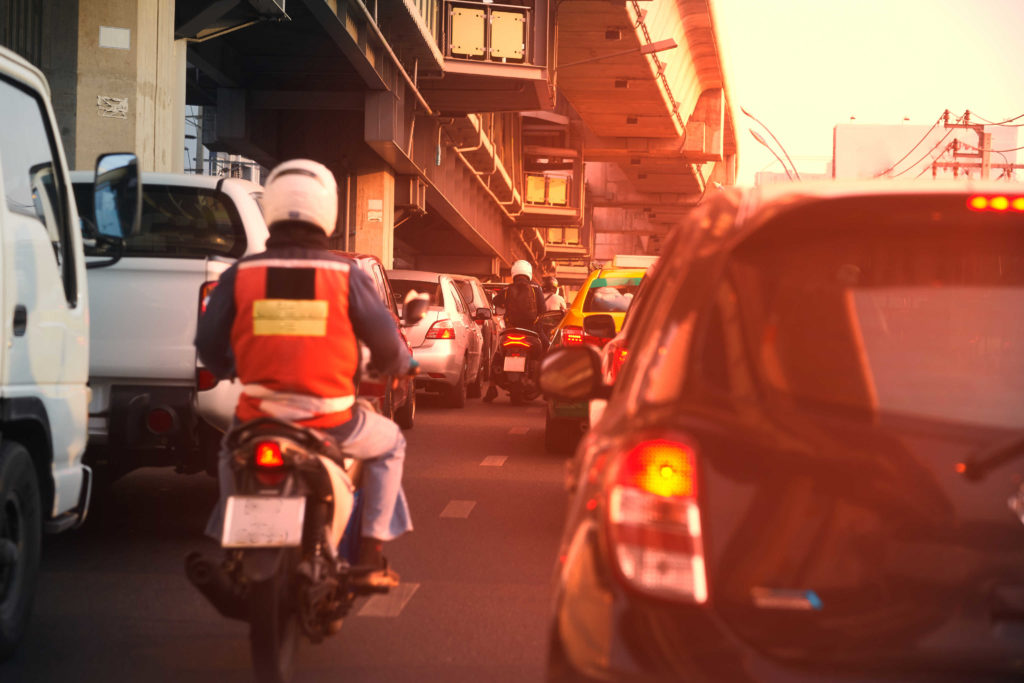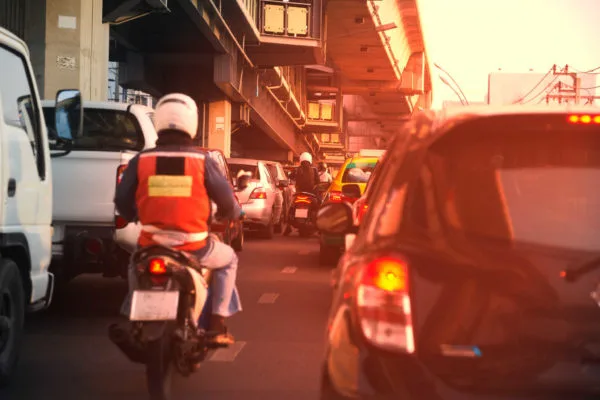Lane splitting has long been a cause for legal debate in the United States. Many consider the act of riding a motorcycle between lanes in standstill traffic dangerous. In fact, in most states, lane splitting is illegal. It’s up to all motorists to obey the law and the rules of the road, regardless of personal opinions or views on the matter.

What is Lane Splitting?
Lane splitting occurs when a motorcyclist passes one or more motor vehicles in the area between two lanes of traffic, often the area of the road where the road line is painted. It is also known as white lining to seasoned motorcyclists. Typically, lane-splitting riders will use white lining to avoid stopping in stopped or slow-moving traffic.
A study by the University of California Berkeley has found that lane splitting may be safer for motorcyclists than traditionally riding during heavy traffic periods. However, two other types of traffic maneuvers motorcycle riders do are similar to lane splitting.
Lane Splitting, Lane Filtering, and Lane Sharing
1. Lane splitting (white lining) – a motorcyclist weaving between moving traffic at a higher speed
2. Lane filtering – a motorcyclist weaving between slower-moving traffic or traffic that is stationary
3. Lane sharing – when two or more motorcyclists are sharing the same lane either side-by-side or staggered
The University of California Berkeley study found that motorcyclists are more likely to be hit from behind by cars. Lane splitting eliminates that possibility for motorcyclists who will pass because no cars can hit them from behind. Additionally, most occur at speeds slower than 50 mph, and at these speeds, injuries are usually less severe overall.
Where is Lane Splitting Legal in the U.S.?
Over the years, several bills have been passed in different states to legalize lane splitting, seeing the benefits of legalization. The following states have legalized the practice. So, for motorcyclists wondering, here are the states where lane splitting is legal:
California
California was one of the first states to embrace lane-splitting even before it was legalized; motorists and motorcyclists respected the practice for years. In 2016, it was declared legal across the state. California is the only state in America to make white lining legal officially. Assembly Bill No. 51.
Arizona
Lawmakers in Arizona first attempted to legalize lane splitting with Senate Bill 1007, but it failed to pass. At the beginning of 2020, however, Representative Noel Campbell introduced House Bill 2285 which aims to restart talks about legalizing white lining in Arizona. Discussions are still underway, but people expect this motion to pass this time. AZ SB1007 | 2020 | Fifty-fourth Legislature 2nd Regular.
Hawaii
Though lane splitting is technically not legal because Hawaii’s roads may be too narrow, the state has allowed shoulder surfing for motorcyclists on the island when there is traffic congestion.
Connecticut
Senate Bill 629 was recently introduced in Connecticut, and lawmakers are currently discussing legalizing lane splitting and filtering. The bill has been referred to the Committee on Transportation, but there hasn’t been any news since proposed. S.B. No. 629. Session Year 2019.
Utah
In March 2019, Utah followed California’s example by becoming the second state to legalize filtering formally. Although it’s not as permissive as white lining, lane filtering can help motorcyclists avoid being tailgated when on the road. Utah lane filtering guidelines.
Oregon
House Bill 2314, a proposition to make lane splitting legal, has been introduced to the Speaker’s desk and is currently in discussion. If the bill passes, motorcyclists will be allowed to travel between cars on roadways with speed limits of 50 mph or more and traffic moving at 10 mph or slower.
Washington
In 2015, Washington introduced a bill to legalize lane splitting, which did not pass. Then, four years later, lawmakers reintroduced Senate Bill 5254, which was left hanging for discussion. On January 13, 2020, the same Senate Bill was reintroduced and is still pending approval.
Virginia
At the beginning of the year, Representative Tony Wilt introduced House Bill 1236 to amend the Code of Virginia, allowing lane splitting in the state. This bill has already been referred to the Committee on Transportation and awaiting approval.
If you happen to live in a state where lane-splitting bills are still pending approval, contact your legislator to support legalization. And if you are involved in an accident while lane splitting, be sure to contact a motorcycle accident lawyer.
Is Lane Splitting Safe?
Wikipedia notes that not much safety research has been done in the United States for lane splitting and lane filtering. However, the European MAIDS report has studied the causes of accidents in four countries related to motorcyclists where lane splitting is legal and one country where it’s illegal. But there is no conclusion as to whether lane-splitting motorcyclists have contributed to accidents or helped prevent them.
The only information we have for the United States about lane splitting safety is comparing motorcycle accidents in states where it’s legal and illegal. For example, in California, the motorcycle accidents from being rear-ended are 30% lower compared to Florida. In California, lane splitting is legal, and in Florida, it is illegal.
It gets lost in a gray area when addressing responsibility and liability issues surrounding white lining. In states where it is legal, motorcyclists involved in an accident could be seen as responsible. At the time of the accident, lane splitting could be used against them in an accident claim because the maneuver was not a safe one to make! This would also make it difficult to prove that the accident wasn’t entirely their fault to adjusters and insurance companies.
Use Caution When Lane Splitting and Call Steinger, Greene & Feiner for All of Your Motorcycle Accident Questions
Although it can be convenient for motorcyclists, lane splitting can also be dangerous and requires extreme caution. Safety measures such as wearing proper gear, using turn signals and horns, and traveling at a safe speed are essential when lane splitting.
As for its legality, the answer is not straightforward. Lane splitting is not explicitly legal or illegal in many states. However, riders who engage in unsafe or reckless behavior may face legal consequences.
Get help from a top-tier motor vehicle accident lawyer if you have been hurt in a car or motorcycle accident. We serve clients across Florida with offices conveniently located in West Palm Beach, Miami, Fort Lauderdale, Tampa, Fort Myers, Orlando, Port St. Lucie, and many more cities throughout the state. Contact Steinger, Greene & Feiner today to learn more about how we can help you if you’ve been injured in an accident.

